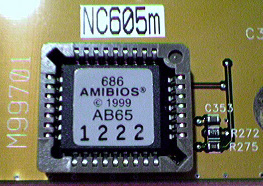|
Inside
the BIOS
Straying
away from the pack, FIC decided to use a less conventional AMI
BIOS, as opposed to the Award BIOS. I have always used Award's
BIOSs before, and there wasn't much of anything that really
caught my eye. Most everything was just basic commands and settings
that usually come standard. I would recommend an AMI BIOS to
the beginner though. AMI's online help is very good, and explains
many of its features very decisively.

Unlike
earlier revisions of this board, the front-side bus settings
of 120MHz and 133MHz were not available in this revision. This
is not really that big of a deal as Overclocking with a gold-finger
type of card will yield much better results. Another downside
was that I was unable to find any form of hardware based CPU/Chipset
temperature monitoring.
Final
Verdict
Overall
the FIC SD11 (rev 1.8) is an improvement over the previous revisions
of the board, but still has a few notable problems. Manly, the
power supply issues, along with the unusually large size of
this board will give some users problems. On the other hand,
at the time of this writing I could find a SD11 on Pricewatch
for as little as $94, much cheaper than they were when they
were first released. With the newer VIA KX133 Athlon boards
already available, this board may not be one worth buying, though
at about $50 less than most it is still a viable option.
by
Ryan Wissman
Price
- 9.2 Performance - 6.5
Overall - 7.0/10
<<
Previous
|